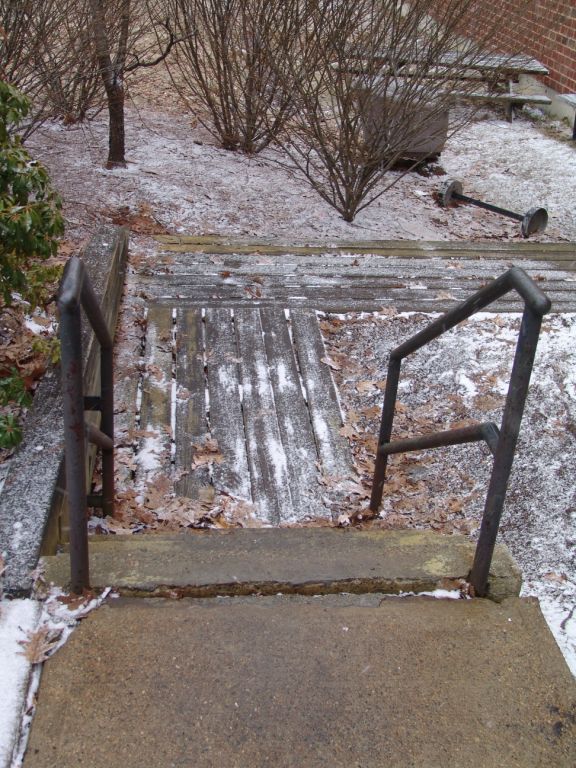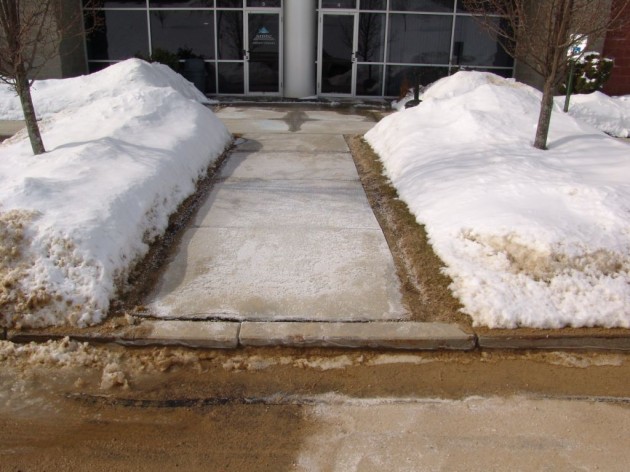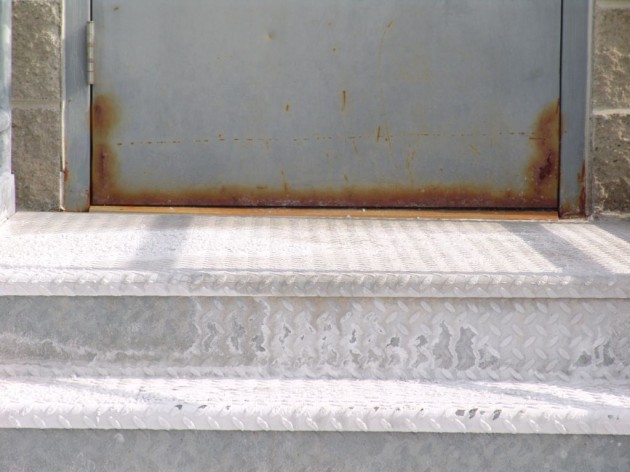“What’s the best deicer to use?” We hear that question virtually every day and our answer is always the same; it depends on the surface you are trying to manage.
Building materials have taken some quantum leaps in recent decades and the surfaces that we had to manage for snow and ice control thirty years are still there, however quite a few new surfaces and landscape features have evolved that require some understanding of ice melters in order to properly manage application of them on these newer materials.
For example; you might be asked “what is the best deicer for a residential deck surface?” Properly managing snow on deck surfaces requires the snow fighter to first understand the exact nature of construction of the deck itself. On first blush the average snow fighter would likely simply apply whatever he’s using on the sidewalks or even the parking lots. That could be a fatal mistake if the deck material and fastener system holding it together are not considered before deicers are used.

While not overly common in commercial properties, wooden decks adorn a vast majority of single family homes, condominiums, and apartments in North America. It’s a common feature that is outside and will catch snow and ice equally with the parking lot in most cases. Wood is by nature capillary and accordingly it will hold moisture. If you look at the photo of the concrete steps leading down to a wooden deck walkway, you can see how the snow is sticking to the colder wooden surface and not on the concrete surface. Because of that fact and the exposure to weather, typically stainless or galvanized fasteners are used to fasten the surface to the joists and the rim joist to the building (galvanized lag bolts). Chloride based deicers are corrosive to many different types of metals. If you were to use a chloride based deicer, the chlorides may and likely would attack the fastener system and in time will eat away at it and cause the fasteners to dissolve even if only ever so slightly. Deicers were implicated as a contributing factor in the sensational bridge collapse in Minn. a few years ago. A loose nail or screw does not hold and while a nail or screw that is driven in is normally nice and tight and does a great job of holding, start eroding (shrinking) that fastener with chloride deicers and you could compromise the fasteners and ultimately face a catastrophic failure.
I am speaking from direct experience in this context: A large group of close friends were relaxing on a large sun deck at a ski chalet in Vermont some years ago when the fasteners holding the deck to the house gave way and the entire structure suddenly fell from the house side while the outboard upright supports briefly held. The people that were standing on the deck were instantly piled up in the crotch of the collapse and seconds later the uprights that were holding the outer rim of the deck fell and the deck then kicked first out and then back as it landed and all of the people that were on it were crushed between the building and the kicking deck. These were athletic young skiers who you would think could manage a fall but the incredible part of this collapse was that everyone that was on the deck was injured and most had either broken legs or broken pelvis’. That is a very sobering reminder to me about the necessity of the integrity of fasteners on deck systems, and as a deicer company we try to caution people about this.
So as you decide how you’re going to attack the snow and ice problem on a deck, be careful to evaluate all of the elements of that structure that will be exposed to deicers and then make your decision.
Going back to the wooden deck, wood is capillary and tends to hold moisture by its nature. If you apply hygroscopic deicers to it lightly, you may actually increase the slip and fall danger more than abate it. Calcium chloride and magnesium chloride are great products for most applications, but they are very hygroscopic (attract moisture) and if brines of these materials saturate the capillaries of a wooden deck, they might make that deck more prone to moisture generated slipperiness. We’ve also seen a lot of plastic decking in the last decade and it’s a great material that is enormously popular because of its long life and lack of required maintenance with stain or paint. However, as anyone who’s ever walked on a plastic deck in sneakers that was rain covered knows, when plastic decks are wet they are very slippery. Now add a calcium chloride or magnesium chloride deicer to that plastic surface and you can setup a potential slip and fall while trying to prevent that very risk. Most plastic materials are virtually impervious to deicer brines, the hygroscopic nature of the deicer may actually increase the “oily” factor and slipperiness of the deck surface.
With decks, the variables to carefully consider are the material of construction, the fastener systems, and the overall exposure to the number one natural ice melter in the world; the sun. Decks, whether they are bridges, elevated walkways, or residential sun decks, are the most tricky surface that we face with deicers and that is the time when abrasives are often very beneficial so consider adding sand to the mix if you are responsible for making a deck passable and safe in winter weather.
Another material that we are seeing more of in the snow belt is granite used in a variety of applications from entrance areas to steps. More often than not, these granite slabs and tiles are a polished surface which poses concern about making the surface slick from the use of moisture gathering deicing compounds. Along with granite, many high-end properties are using pavers, slate, and other stone elements set in mortar.
The most common complaint about deicers is concrete damage and that is typically the result of spalling caused by a mechanical attack of melting created liquid brines contained in the air voids of the concrete refreezing, and thereby expanding and breaking apart the concrete mechanically – not chemically. When dealing with stonework set in mortar, the potential for freeze:thaw derived spalling damage is extremely high, and great care must be exercised any time the surface you are treating has stone or other features set in mortar. The brines created by the application of deicers onto the snow and ice covered surface will penetrate the mortar and may cause freeze:thaw related failures. So that beautiful slate walk that was just put in may become an unstable broken up mess; the deicer might be safe for the slate, granite, or stone, but it’s not safe for new concrete.

I plan to cover concrete damage more thoroughly in a future article, however we generally recommend that no chemical deicers are used on concrete less than two years old. Sealing the concrete properly with a professional concrete sealer or paint will help to prevent the resultant brines from filling up the air pockets in air entrained concrete and help to lower the potential for freeze:thaw related damage.
Back to the variety of surfaces that are out there, it is nearly impossible to offer a “one size fits all” deicer for all of these different surfaces because each has its own characteristics that can be impacted by the type of deicer you choose. If you have a surface that can tolerate chlorides, then by all means regular old rock salt will provide the least expensive deicing option. With products like our treated salt, which is rock salt encapsulated with a mixture of magnesium chloride and molasses, users generally see significant performance improvement over untreated salt as the magnesium “wrapper” is the first to brine and helps salt work a lower temperatures than it normally would work.

Understanding that chloride based deicers generally all will attack ferrous metals and many other types of metals found in building systems can help you to avoid costly damage claims. Looking closely at the photo of the doorway, which by the way is less than 3 years old, you can see that the galvanized steel stairs appear to be ok, but the steel door and frame are already showing heavy corrosion damage. Adding corrosion inhibitors to chloride based deicers may help, but you have to understand the inhibitor being applied and whether it is biodegradable or if it has a lifespan that is shorter than the end time of time lifespan on the chloride deicer. Inhibitors are something that are still widely misunderstood in our experience and people mistakenly assume that simply having “an inhibitor” in the product is going to protect their materials which usually they do not!
As you evaluate any property and the variety of surfaces to be deiced, always think beyond the surface; think about where the mixture of deicer and melt water will go and how that mixture might introduce new concerns if at all. On the surfaces themselves, be sure to carefully consider all of the components that will be exposed to the resulting brines or melted snow and make sure that the deicer you’re using is not going to attack secondary non-target components such as re-bar, steel stairs, aluminum door frames and thresholds, mortar and concrete used to hold stones, granite, or other architectural landscaping features. Also, understand that any snow that is thrown or plowed off that contains deicers also will then contaminate the point of final rest where they melt down and enter ground water potentially affecting shrubs, turf, and other plantings.
The most important thing you can do as an ice melt product buyer is to demand that your supplier gives you a certified statement of ingredients. If you are buying a product called “The World’s Safest Deicer”, then you are entitled to a complete detailed analysis of the ingredients listing them by descending percentages in detail. There are a lot of smoke and mirrors out there in packaged deicers and just because there are puppies, babies, and pine trees on the bag and it has a statement of being safe for the environment or it “contains” CMA does not mean that the material is automatically safe! The US Federal Right to Know law entitles every ice melt product buyer to a statement of ingredients; it is the law. Do not take the salesman’s word for it; if you are buying 96% rock salt and 4% filler you have a legal right to know that. If they claim it is protected by a patent, then ask for the patent number or point out the obvious; the very purpose of a patent is to protect the inventor by public disclosure of his invention – so if it’s patented, IT’S NOT A SECRET! We are as an industry fighting labeling problems and we encourage all buyers of ice melter products to demand a full disclosure, in writing, and certified as to the formula and ingredients BY PERCENTAGE in any ice melt product you buy. We will provide these on any product that we sell, and we applaud Cargill Salt for printing their formulas on their bags this year and helping to straighten out this massive label deception that is suddenly prevalent in packaged melters.